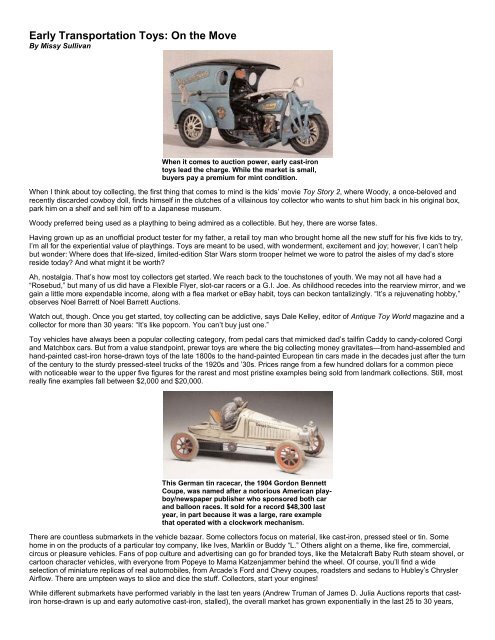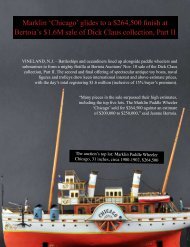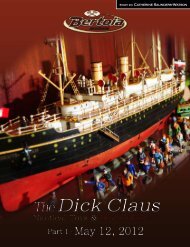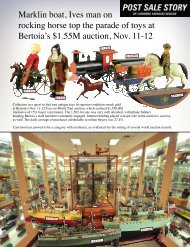Early Transportation Toys: On the Move - Bertoia Auctions
Early Transportation Toys: On the Move - Bertoia Auctions
Early Transportation Toys: On the Move - Bertoia Auctions
You also want an ePaper? Increase the reach of your titles
YUMPU automatically turns print PDFs into web optimized ePapers that Google loves.
<strong>Early</strong> <strong>Transportation</strong> <strong>Toys</strong>: <strong>On</strong> <strong>the</strong> <strong>Move</strong><br />
By Missy Sullivan<br />
When it comes to auction power, early cast-iron<br />
toys lead <strong>the</strong> charge. While <strong>the</strong> market is small,<br />
buyers pay a premium for mint condition.<br />
When I think about toy collecting, <strong>the</strong> first thing that comes to mind is <strong>the</strong> kids’ movie Toy Story 2, where Woody, a once-beloved and<br />
recently discarded cowboy doll, finds himself in <strong>the</strong> clutches of a villainous toy collector who wants to shut him back in his original box,<br />
park him on a shelf and sell him off to a Japanese museum.<br />
Woody preferred being used as a plaything to being admired as a collectible. But hey, <strong>the</strong>re are worse fates.<br />
Having grown up as an unofficial product tester for my fa<strong>the</strong>r, a retail toy man who brought home all <strong>the</strong> new stuff for his five kids to try,<br />
I’m all for <strong>the</strong> experiential value of playthings. <strong>Toys</strong> are meant to be used, with wonderment, excitement and joy; however, I can’t help<br />
but wonder: Where does that life-sized, limited-edition Star Wars storm trooper helmet we wore to patrol <strong>the</strong> aisles of my dad’s store<br />
reside today? And what might it be worth?<br />
Ah, nostalgia. That’s how most toy collectors get started. We reach back to <strong>the</strong> touchstones of youth. We may not all have had a<br />
“Rosebud,” but many of us did have a Flexible Flyer, slot-car racers or a G.I. Joe. As childhood recedes into <strong>the</strong> rearview mirror, and we<br />
gain a little more expendable income, along with a flea market or eBay habit, toys can beckon tantalizingly. “It’s a rejuvenating hobby,”<br />
observes Noel Barrett of Noel Barrett <strong>Auctions</strong>.<br />
Watch out, though. <strong>On</strong>ce you get started, toy collecting can be addictive, says Dale Kelley, editor of Antique Toy World magazine and a<br />
collector for more than 30 years: “It’s like popcorn. You can’t buy just one.”<br />
Toy vehicles have always been a popular collecting category, from pedal cars that mimicked dad’s tailfin Caddy to candy-colored Corgi<br />
and Matchbox cars. But from a value standpoint, prewar toys are where <strong>the</strong> big collecting money gravitates—from hand-assembled and<br />
hand-painted cast-iron horse-drawn toys of <strong>the</strong> late 1800s to <strong>the</strong> hand-painted European tin cars made in <strong>the</strong> decades just after <strong>the</strong> turn<br />
of <strong>the</strong> century to <strong>the</strong> sturdy pressed-steel trucks of <strong>the</strong> 1920s and ’30s. Prices range from a few hundred dollars for a common piece<br />
with noticeable wear to <strong>the</strong> upper five figures for <strong>the</strong> rarest and most pristine examples being sold from landmark collections. Still, most<br />
really fine examples fall between $2,000 and $20,000.<br />
This German tin racecar, <strong>the</strong> 1904 Gordon Bennett<br />
Coupe, was named after a notorious American playboy/newspaper<br />
publisher who sponsored both car<br />
and balloon races. It sold for a record $48,300 last<br />
year, in part because it was a large, rare example<br />
that operated with a clockwork mechanism.<br />
There are countless submarkets in <strong>the</strong> vehicle bazaar. Some collectors focus on material, like cast-iron, pressed steel or tin. Some<br />
home in on <strong>the</strong> products of a particular toy company, like Ives, Marklin or Buddy “L.” O<strong>the</strong>rs alight on a <strong>the</strong>me, like fire, commercial,<br />
circus or pleasure vehicles. Fans of pop culture and advertising can go for branded toys, like <strong>the</strong> Metalcraft Baby Ruth steam shovel, or<br />
cartoon character vehicles, with everyone from Popeye to Mama Katzenjammer behind <strong>the</strong> wheel. Of course, you’ll find a wide<br />
selection of miniature replicas of real automobiles, from Arcade’s Ford and Chevy coupes, roadsters and sedans to Hubley’s Chrysler<br />
Airflow. There are umpteen ways to slice and dice <strong>the</strong> stuff. Collectors, start your engines!<br />
While different submarkets have performed variably in <strong>the</strong> last ten years (Andrew Truman of James D. Julia <strong>Auctions</strong> reports that castiron<br />
horse-drawn is up and early automotive cast-iron, stalled), <strong>the</strong> overall market has grown exponentially in <strong>the</strong> last 25 to 30 years,
especially at <strong>the</strong> top end. According to Dale Kelley, who founded <strong>the</strong> Chicago Toy Show in 1974 and has been running it ever since,<br />
you could buy any Buddy “L” pressed-steel truck in <strong>the</strong> show for $25 that first year. When Kelley sold a mint 24-inch, Buddy “L” Red<br />
Baby pickup truck in 1976 for $400, it was <strong>the</strong> biggest price ever for a Buddy. When that same Red Baby emerged on <strong>the</strong> market again<br />
in 1999, it soared to $22,000. (A 5400% appreciation over 23 years? Not bad!) Collector Bob Brady spent $4,500 to acquire a pristine<br />
1928 Hubley cast-iron Harley-Davidson Parcel Post motorcycle with a hinged rear door and <strong>the</strong> original wood-beaded pull string in <strong>the</strong><br />
mid 1980s; he sold it last year for $30,000.<br />
<strong>On</strong>e accelerant to <strong>the</strong> markets over <strong>the</strong> last ten years? The emergence of several long-held collections. In 2001 alone, three monster<br />
sales unleashed a torrent of quality material, from <strong>the</strong> F.H. Griffith and Covert Hegarty auctions of cast-iron gems to <strong>the</strong> long-awaited<br />
dispersal of <strong>the</strong> Buddy “L” company archive of toys, samples and prototypes at Randy Inman <strong>Auctions</strong>. In 2005 <strong>the</strong> Bob Brady and Bob<br />
and Jackie Stewart collections brought even more top-notch cast-iron material to light.<br />
The flip side of that trend is that <strong>the</strong> collector pool for this material is generally graying, with only a recent infusion of younger blood. So<br />
as some collectors cash out, and o<strong>the</strong>rs fill holes in <strong>the</strong>ir collections, competition at <strong>the</strong> top can get skimpy.<br />
Meanwhile, at <strong>the</strong> lower end of <strong>the</strong> market, eBay has done a good job in helping to define <strong>the</strong> universe of what’s common. Says Dan<br />
Morphy of Morphy <strong>Auctions</strong>, “An Arcade cast-iron taxi in really nice condition that brought $7,000 to $10,000 ten years ago will sell<br />
between $4,000 to $5,000 today because more have turned up.” The site has also brought in a lot of new collectors. Most tend to start<br />
with material <strong>the</strong>y played with or wanted as a kid. Then, as <strong>the</strong>ir eye and taste begin to refine, <strong>the</strong>y often come to appreciate <strong>the</strong><br />
craftsmanship and charm of <strong>the</strong> older pieces and move to live auctions.<br />
What brings value in prewar transportation toys? Above all, condition and desirability. Rarity counts, but if a toy doesn’t set hearts athumping,<br />
it doesn’t matter how rare it is. To understand what <strong>the</strong> market prizes, we only need look at <strong>the</strong> two top-priced items in <strong>the</strong><br />
past few years: a “Say it with Flowers” motorcycle van (see above) that fetched $126,750 in 2001 and a 1880s Carpenter cast-iron<br />
horse-drawn Tally Ho. Both were rare, large examples of <strong>the</strong>ir form. Both were completely original, unrestored, with vibrant paint, in<br />
never-played-with condition. Both came from significant private collections.<br />
Size definitely makes a difference in value. Many companies issues certain vehicles in a range of sizes and luxury options. Maybe<br />
because <strong>the</strong>y were more likely to have been played with outside and suffered more from <strong>the</strong> elements, larger examples tend to be<br />
scarcer. A mint David’s moving van, for example, can sell for $4,000 to $5,000, while one three times <strong>the</strong> size would bring $25,000.<br />
And how is condition assessed? Significant condition problems can drop <strong>the</strong> price by 50%, says Rich <strong>Bertoia</strong> of <strong>Bertoia</strong> <strong>Auctions</strong>. For<br />
<strong>the</strong> most part, restoration is frowned on, especially a wholesale repainting of something that had mostly original paint to begin with.<br />
Connoisseurs prefer honest playwear to a shiny-new restored surface. But, says cast-iron collector, restorer and dealer Russ<br />
Harrington, <strong>the</strong> rarer and valuable <strong>the</strong> toy, <strong>the</strong> more it can withstand <strong>the</strong> scourge of being restored and having substitute parts. Many of<br />
<strong>the</strong>se toys came with separate accessories—from drivers and passengers to fire hoses and buckets. Leila Dunbar of So<strong>the</strong>by’s cites<br />
<strong>the</strong> example of a Hubley cast-iron Indian sidecar motorcycle that sold for $20,300. <strong>On</strong>e of <strong>the</strong> reasons it commanded a premium: it had<br />
all of its original civilian figures. If <strong>the</strong> figures had been replaced, it would’ve sold closer to $6,000, she speculates. And because most<br />
Hubley figures were police figures, <strong>the</strong>y are <strong>the</strong> most common replacements. Had police figures been substituted, she estimates that<br />
<strong>the</strong> value would’ve dropped to $3,500.<br />
Original boxes can also add punch to a price: up to 30% or more, depending on <strong>the</strong>ir age, rarity and design. Boxes for early cast-iron<br />
cars were often non-descript, while those for German lithographed tin toys could often fairly elaborately decorated.<br />
Herein, a quick rundown of <strong>the</strong> markets for prewar cast-iron, tin and pressed steel toys.<br />
This 1925 27-inch Buddy “L” Insurance Patrol truck<br />
smashed all records for pressed steel cars at<br />
$40,700. Why? It’s <strong>the</strong> only known example, it came<br />
with its original box and it hailed from <strong>the</strong><br />
company’s own historic archive.<br />
Cast-iron transportation toys: Cast-iron horse-drawn vehicles appeared on <strong>the</strong> American toy scene starting in <strong>the</strong> last quarter of <strong>the</strong><br />
19th century. Ranging from buggies, brakes and cabriolets to fire hose reels and circus wagons, <strong>the</strong>y are <strong>the</strong> oldest, rarest and most<br />
thoroughly handcrafted of <strong>the</strong> three categories. While parts were made with steel patterns, <strong>the</strong>y were hand assembled and painted.<br />
Important makers include Carpenter, Hubley, Ives, and Welker & Crosby, among o<strong>the</strong>rs.<br />
Compared to <strong>the</strong> go-go market for cast-iron mechanical banks, which regularly reaches into six figures for <strong>the</strong> best examples, cast-iron<br />
horse-drawn toys are still relatively undervalued, asserts John Olshefski, a California-based collector whose reference guide on <strong>the</strong><br />
subject is due out this winter. You can build a top-notch collection, he contends, without spending any more than $3,000 to $10,000 per<br />
piece. <strong>On</strong>ly a handful of pieces sell in <strong>the</strong> mid or high five figures. The Holy grail of horse-drawn? The Carpenter Tally Ho coach, a<br />
complex rig with four horses, a driver, and six splendidly dressed passengers sitting atop a midnight blue coach with red-spoked<br />
wheels. It has sold between $20,000 and $92,000 in <strong>the</strong> last few years, depending on condition.
After <strong>the</strong> turn of <strong>the</strong> century, when motoring came into vogue, cast-iron toys reflected <strong>the</strong> shift. As Rich <strong>Bertoia</strong> explains, this segment of<br />
<strong>the</strong> market has been <strong>the</strong> most in flux: “Twelve years ago, <strong>the</strong>re was an abundance of collectors. They were elderly <strong>the</strong>n and <strong>the</strong>y’ve<br />
been dwindling. The market sagged for a while, but in <strong>the</strong> last three years, I’ve seen a big change. More young guys are moving in—as<br />
many investors as toy collectors.” The steadiest sellers: luxury vehicles like open roadsters and sexier cars. To illustrate <strong>the</strong> rebound,<br />
<strong>Bertoia</strong> cites a 1927 Arcade replica of a luxe Buick coupe, very colorful in blues and blacks, with a white spare tire and a nickeled driver<br />
seated in <strong>the</strong> front seat. Eight years ago, it sold for $14,000. Five years ago, <strong>the</strong> same piece went for $7,000. And last month, a similar<br />
one sold for $13,500.<br />
Tin automobiles: Driving <strong>the</strong> top of <strong>the</strong> tin market are vehicles from <strong>the</strong> earliest years of motoring, from 1900 to World War I, by<br />
European makers like Carette, Gun<strong>the</strong>rmann, Lehmann, Bing and Marklin. With <strong>the</strong> euro strong against <strong>the</strong> dollar, many current buyers<br />
hail from <strong>the</strong> continent, seemingly reclaiming <strong>the</strong>ir tin toy heritage.<br />
<strong>On</strong>e of <strong>the</strong> hardest things to do with rare cast-iron<br />
toys? Find an example that has all of its original<br />
parts. This c. 1880s Wilkins chemical wagon is not<br />
only an unusual item, but all of its parts—from <strong>the</strong><br />
figures to <strong>the</strong> buckets—are 100% original and<br />
complete.<br />
Carette is particularly well known for its extensive line of toys, with its limousines being <strong>the</strong> most prized, says Noel Barrett of Noel<br />
Barrett <strong>Auctions</strong>. The best models had compartments for <strong>the</strong> chauffeur, doors that opened and details like beveled glass windows.<br />
Ano<strong>the</strong>r high-selling marquee is Marklin, which Barrett describes as “<strong>the</strong> luxe deluxe. They were hand-painted, finely crafted with a<br />
certain special quality in everything <strong>the</strong>y made.” These were toy cars made for <strong>the</strong> very wealthy, depicting full-sized cars driven by <strong>the</strong><br />
very wealthy.<br />
The most desirable tin cars are those that were hand-enameled. While <strong>the</strong> later lithographed tin examples often had a more realistic<br />
feel, <strong>the</strong>y lost that handmade quality. Barrett recently sold a c. 1910 hand-enameled Carette limousine for $8,500, which had <strong>the</strong> added<br />
value of passengers in <strong>the</strong> back. Without <strong>the</strong> passengers, it would’ve been worth $4,500. And if it were lithographed, <strong>the</strong> value would’ve<br />
dropped to between $2,500 and $3,000.<br />
Pressed steel: The market for pressed steel vehicles has been going pedal to <strong>the</strong> metal in <strong>the</strong> last five years, notes Dan Morphy. Case<br />
in point: a spiffy red American National 1930s Packard convertible, with black walls, yellow pin striping, a spare wheel on <strong>the</strong> running<br />
board and a bell on <strong>the</strong> hood sold last year at <strong>Bertoia</strong> <strong>Auctions</strong> for $24,000. Five years earlier, <strong>Bertoia</strong> estimates, it would’ve brought<br />
half that price. And while American National examples are rarer and o<strong>the</strong>r makers abounded, included Keystone, Structo, Wilkins and<br />
Dayton, <strong>the</strong> pressed steel market has long been dominated by Buddy “L” with its durable, well-built trucks. The 300-pound Buddy<br />
avowed to have stood on every truck that came off <strong>the</strong> assembly line to make sure that kids couldn’t break <strong>the</strong>m. How many collectibles<br />
can make that claim?<br />
— Missy Sullivan






